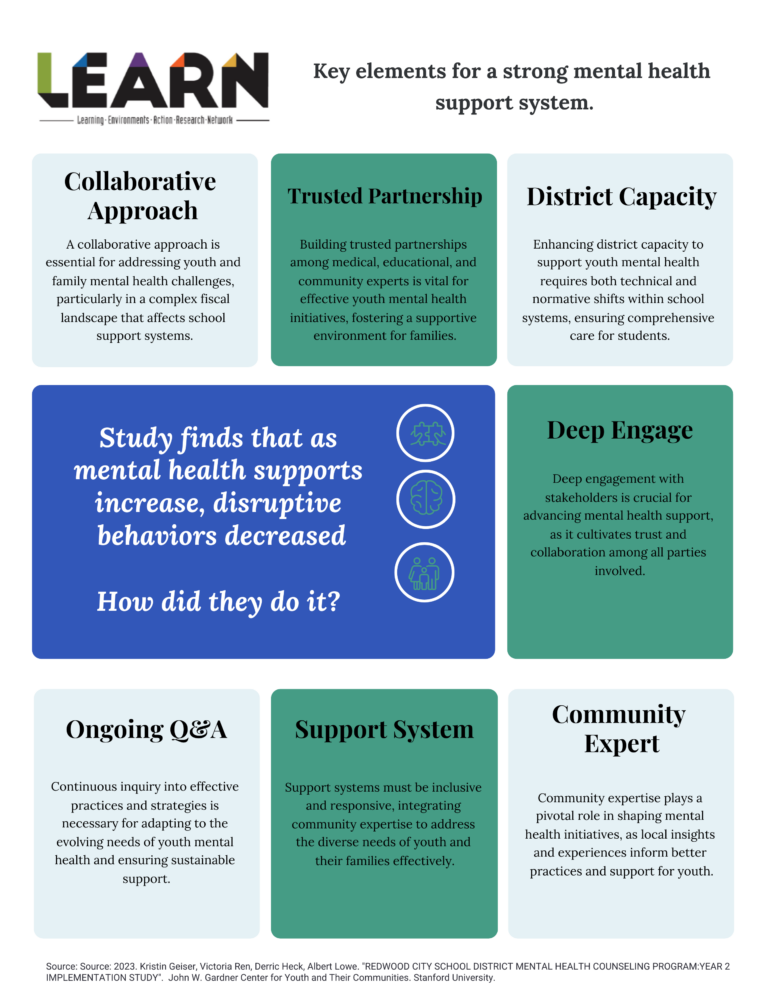Background
In response to growing mental health needs among students—made more urgent by the effects of the COVID-19 pandemic—Redwood City School District (RCSD) took a major step in 2021 by placing a full-time mental health counselor at each of its 12 schools. These counselors work directly for the district and focus on student mental health and wellbeing. To understand how the program is working, Stanford’s John W. Gardner Center has partnered with RCSD for the past two years. Their latest study (2022–2023) looks at how the counseling program has evolved, how it’s making a difference, and how it can be improved moving forward.
Source: 2023. Kristin Geiser, Victoria Ren, Derric Heck, Albert Lowe. “REDWOOD CITY SCHOOL DISTRICT MENTAL HEALTH COUNSELING PROGRAM:YEAR 2 IMPLEMENTATION STUDY”. John W. Gardner Center for Youth and Their Communities. Stanford University.
Questions and Methods
Researchers conducted:
- 19 interviews with counselors and school/district leaders
- 22 observations of meetings related to student services
The study focused on three key questions:
- What do counselors do?
- What signs show the program is working?
- How can the program be strengthened in its third year?
District Context
There are just over 6,000 students in grades TK-8 in this diverse CA district with the largest ethnic group being Hispanic/Latino (68%). Schools in the district ranged from 1% to 88% qualifying for free and reduced lunch and between 1% and 67% multi-lingual learners.
The Role of Counselors
Counselors in RCSD schools offer a wide range of supports—from individual therapy and crisis intervention to classroom lessons and staff collaboration. Their role includes:
- Helping students understand and manage emotions
- Supporting teachers with student wellbeing
- Creating school-wide systems of care
While their exact responsibilities vary by school, they are seen as essential to both student and staff wellbeing.
Findings
Researchers found signs of impact across four levels:
1. Individual Level
- In 2022–23, counselors provided over 14,000 services, up from about 10,000 the previous year.
- Over 2,200 students (36%) received individual or group counseling.
- Students are learning emotional skills, using calming strategies, and seeking help when needed.
- Staff have noticed students resolving conflicts on their own and rejoining class more quickly after emotional upsets.
2. School Level
- Counselors are a trusted resource for staff, bringing peace of mind and helping create a proactive, rather than reactive, approach to mental health.
- Teachers and administrators say counselors reduce stress and improve the overall school climate.
- Counselors also support staff mental health by being available as thought partners and experts.
3. District/System Level
- The program has improved the district’s ability to respond to crises—like potential suicide risks—more safely and compassionately.
- Counselors help ensure students and families receive the right level of care, avoiding unnecessary emergency interventions.
- These efforts help stabilize entire school communities during difficult moments.
4. Connection to Teaching and Learning
- Better mental health support means fewer classroom disruptions and more consistent learning time.
- Students are able to return to class more quickly after moments of distress.
- Administrators say this support helps “brains and bodies feel ready to learn,” which benefits everyone in the classroom.
Next Steps for This Collaborative
The study suggests three ways to enhance the program:
1. Expand Basic (Tier 1) Mental Health Supports
While counselors provide some schoolwide supports, RCSD could broaden reach by using other tools—like expanding Positive Behavioral Interventions and Supports (PBIS) or including mental health screenings during school registration. This would allow counselors to focus more on students needing deeper (Tier 2 or Tier 3) support.
2. Improve Evaluation Tools and Practices
Now that the program is more established, the district should develop a clear “theory of change” that outlines short- and long-term goals. This would include better data systems to track outcomes—like learning, achievement, and how well the program serves students from different cultural backgrounds.
3. Deepen Counselors’ Integration into Schools
Strong relationships help reduce stigma and make it easier for students and families to seek help. Continued effort to build trust—especially in historically underserved communities—is key to the program’s long-term success.
Conclusion: Building a Healthier School System
Mental health challenges affect learning—and while supporting individual students is critical, this study reminds us that schools themselves must evolve to meet these needs. RCSD’s counseling program is helping transform not just individual lives, but also the climate of schools and the district as a whole.
